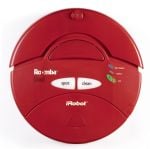This article is more than 1 year old
Why do robot experts build such lousy robots?
We meet the nerds with the world's cleanest floors
This robot sucks
 Neither Lego nor Pleo could compete with the other robot on display, the hockey-puck-shaped Roomba autonomous vacuum cleaner. Roomba can navigate a room while vacuuming up dust, and return to his dock to recharge afterwards. That's pure utility, according to iRobot CEO Colin Angle, a money-saving and time-saving service for which people are happy to pay, and that's what it will take to move the robotics "industry" into a self-sustaining mode.
Neither Lego nor Pleo could compete with the other robot on display, the hockey-puck-shaped Roomba autonomous vacuum cleaner. Roomba can navigate a room while vacuuming up dust, and return to his dock to recharge afterwards. That's pure utility, according to iRobot CEO Colin Angle, a money-saving and time-saving service for which people are happy to pay, and that's what it will take to move the robotics "industry" into a self-sustaining mode.
He's right about the business angle, but at two million units sold, it's not yet even a Furby. On the other hand, it is an actual autonomous robot, and less faddish than the Furby too. Based on this success, after almost two decades of trying, iRobot is branching out into automatic floor-scrubbers, pool-cleaners, and bomb-defusers - that last one not yet available for the consumer market, unfortunately.
Yet apparently, robot-love is still driving much of that "utility" market.
Most Roomba owners give affectionate names to their toys vacuums. To satisfy the robot-lovers, iRobot has a new Roomba model, called Create, which is in fact a non-vacuuming version with a "payload bay" for aspiring roboticists. The toy Pleo will also likewise be opened up for creative customer tinkering and hacking (any bets on the first copulating dinosaurs?), meaning that all three consumer products on show at this seminar are explicitly chasing the tinkerer market by becoming tool-kits. So making and playing with robots evidently beats using and ignoring them.
The geeks with the world's cleanest floors
The "roll your own" approach to robotics obviously attracts customers, but it also conveniently outsources to consumers the single biggest barrier to any kind of autonomous gadget: making sense of and acting in the world. Gathering sensor data is a piece of cake compared to analyzing it; hooking up motors is nothing compared to deciding just how to drive them, and deciding if it worked. So it was fitting that the remaining panelist, Prof. Sebastian Thrun of Stanford, specializes in computer-vision research rather than industrial gadget-building.
His fame comes from building the winning car in the DARPA Grand Challenge desert road-race. He did the opposite of what these gadget-makers are doing; he effectively outsourced the mechanical car to Volkswagen, and focused his team on the statistical-inference software necessary to actually drive it. Next to the robo-boosters on stage, he appears gentle and self-effacing, speaking carefully in his conflicting roles as the most visible proponent of a new industry - he's given a hundred talks in the last year - and as a careful researcher in a field littered with oversold and under-performing "breakthroughs".
The fact is, what allowed Thrun's car (Stanford's "Stanley") to cross a hundred miles of desert dirt unaided was not mechanical wizardry or "intelligence," but the careful application of statistical inference and software design to merging three kinds of sensor data: GPS coordinates, laser range-finders, and video color/texture signals. The secret sauce was in detecting the road fifty metres ahead and avoiding large obstacles, and even that apparently simple task consumed a year of the lives of a dozen computer science graduate students. It's hard to imagine Joe Tinkerer doing such things at home with his Mindstorms kit.
Thrun threw cold water on the idea of immediate robot gratification. His ultimate goal is a self-driving car, a vehicle which would be a safer and more attentive driver than humans, freeing our minds from the roadway, speeding traffic by packing cars closely. This indeed would be a pivotal social and technological revolution - more so than floor cleaners and cuddly toys - but Thrun is the first to admit that it is still a pipe-dream, dozens of years away in technology, and blocked by liability lawyers at every turn. In planning his upcoming car-contest entry, he is consumed by an apparently simple challenge: how a computer vision system might detect moving objects and predict their motion, a task at which frogs are still in the lead.
So for the time being, the so-called "robot industry" looks to be dominated by factory assemblers, remote-controlled rovers, clever toys, DIY kit, and cleaning devices which roam the floors of indulgent early-adopters. But not by truly autonomous agents which can operate in the outside world unsupervised.
For that, we need breakthroughs both in statistical inference software and in the business of robotics itself. And we'll examine this in Part Two, next week. Stay tuned. ®
